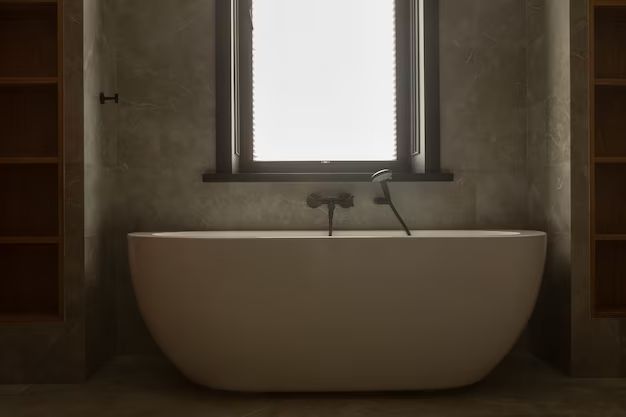When it comes to choosing materials for tub surrounds, homeowners have several options to consider. Acrylic is one popular choice due to its durability, easy maintenance, and customizability. However, some homeowners may wonder if acrylic is truly the best material for tub surrounds or if other options like tile or fiberglass might be better. This article will examine the pros and cons of using acrylic for tub surrounds to help homeowners decide if it is the right choice for their bathroom remodel.
Page Contents
Acrylic Tub Surround Pros
Here are some of the benefits that make acrylic a good option to consider for tub surrounds:
- Durability – Acrylic is a very durable material that can last for many years with proper care. It resists scratches, dents, and moisture damage better than many other tub surround materials.
- Easy maintenance – Acrylic tub surrounds are non-porous, so they resist staining, mold, and mildew growth. They can be easily cleaned with mild soap and water.
- Customizability – Acrylic surrounds can be molded into virtually any shape to fit the specific tub area. They can also be customized with color options.
- Affordability – Acrylic is one of the more budget-friendly options for tub surrounds, especially compared to tile or stone. The material itself is relatively inexpensive.
- Fast installation – Acrylic surrounds can be installed in as little as a day, unlike tile which requires a longer installation process. This results in less disruption to the home.
- Good insulation – Acrylic provides decent insulation for the tub area, helping keep bath water hotter for longer.
- Aesthetics – Acrylic can mimic the look of more expensive materials like ceramic tile, but at a lower cost. The seams are barely visible.
Acrylic Tub Surround Cons
However, there are some downsides to consider with acrylic surrounds as well:
- Not as durable as tile – Although durable for a plastic, acrylic lacks the hardness and longevity of ceramic tile. It is prone to deeper scratches and gouges over time.
- Prone to dulling – Acrylic often loses its luster and becomes dull over time, whereas tile maintains its shine. Frequent polishing is required to keep acrylic looking new.
- Can stain – Although resistant to staining, acrylic can become stained by hair dyes, soaps, and other products especially if not cleaned frequently.
- Prone to yellowing – Acrylic yellows when exposed to sunlight over time. Keeping the bathroom well-ventilated can help minimize this effect.
- Less waterproof – Acrylic surrounds are water-resistant, but not 100% waterproof like tile. Moisture can eventually seep into seams and cause mildew or leaks.
- Challenging repairs – Repairing scratches, chips, or cracks in acrylic is difficult and rarely blends seamlessly. Often the entire surround requires replacement.
- Limited styles – Although customization options exist, acrylic has fewer patterns, textures, and colors available compared to ceramic or glass tile options.
Acrylic vs. Fiberglass Tub Surrounds
Many homeowners also consider fiberglass as an alternative to acrylic for tub surrounds. How do these two materials compare?
| Factor | Acrylic | Fiberglass |
|---|---|---|
| Durability | Very durable, but can scratch/dent | Prone to scratching and punctures |
| Repairability | Difficult to repair seams or damage | Nearly impossible to repair once damaged |
| Customization | Can be molded into any size/shape | Difficult to customize after initial fabrication |
| Appearance | Seamless look, wide color/pattern options | Visible seams, limited color/pattern options |
| Cleaning | Easy to clean with just soap and water | Prone to soap scum buildup, harder to clean |
| Cost | $$$ | $ |
In summary, acrylic is more durable, customizable, attractive, and easier to clean compared to fiberglass. However, fiberglass is a less expensive option. For longevity and quality, acrylic tends to be the better material for tub surrounds.
Acrylic vs. Ceramic Tile Tub Surrounds
Here’s how acrylic and ceramic tile compare for tub surrounds:
| Factor | Acrylic | Ceramic Tile |
|---|---|---|
| Durability | Prone to scratches/dents over time | Extremely durable and scratch-resistant |
| Water Resistance | Water-resistant only, not waterproof | Fully waterproof, low maintenance |
| Cleaning | Easy to clean | Prone to soap scum/hard water buildup |
| Appearance | Seamless, some style/color limitations | Natural stone look, unlimited styles/colors |
| Installation Time | 1-2 days | 3-5 days |
| Cost | $$$ | $$$$ |
Tile is more durable, waterproof, and beautiful but requires extensive installation time. Acrylic installs faster and costs less but lacks tile’s resilience. Ultimately, tile provides a higher-end look at a higher price point.
Conclusion
Acrylic makes a great choice for tub surrounds in many homes due to its durability, customization options, easy maintenance, and affordability compared to other materials. It provides a seamless, attractive look and feel. However, tile exceeds acrylic in terms of waterproofing, durability, and high-end aesthetics. Weighing the pros and cons of acrylic versus other materials can help homeowners decide what fits best for their specific tub surround project needs and budget.
